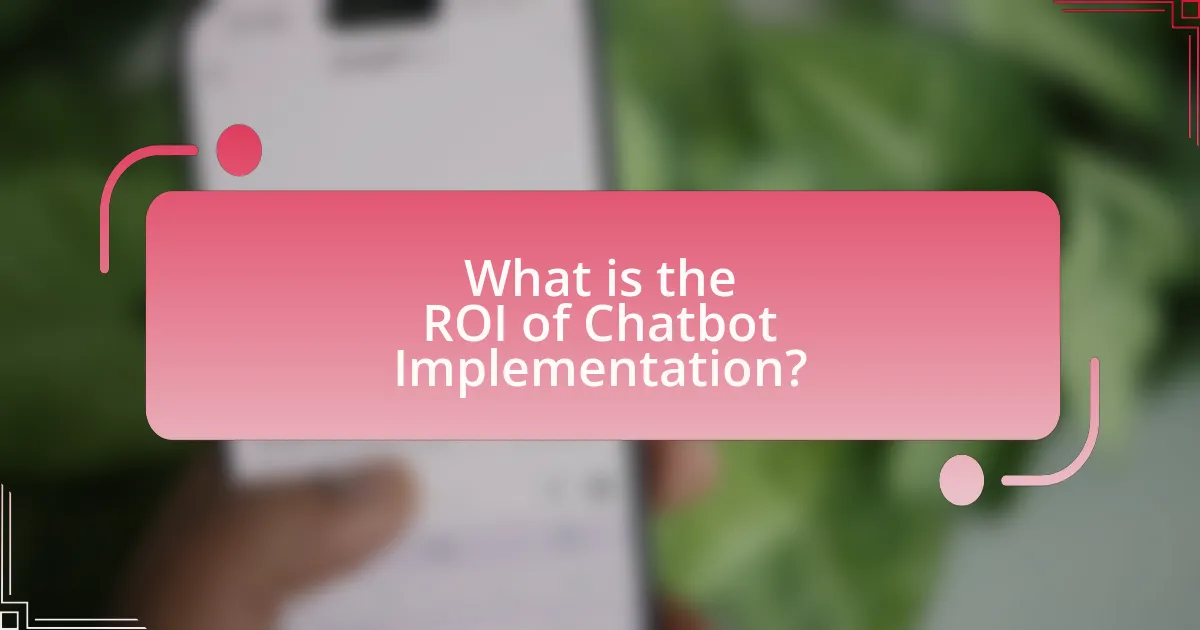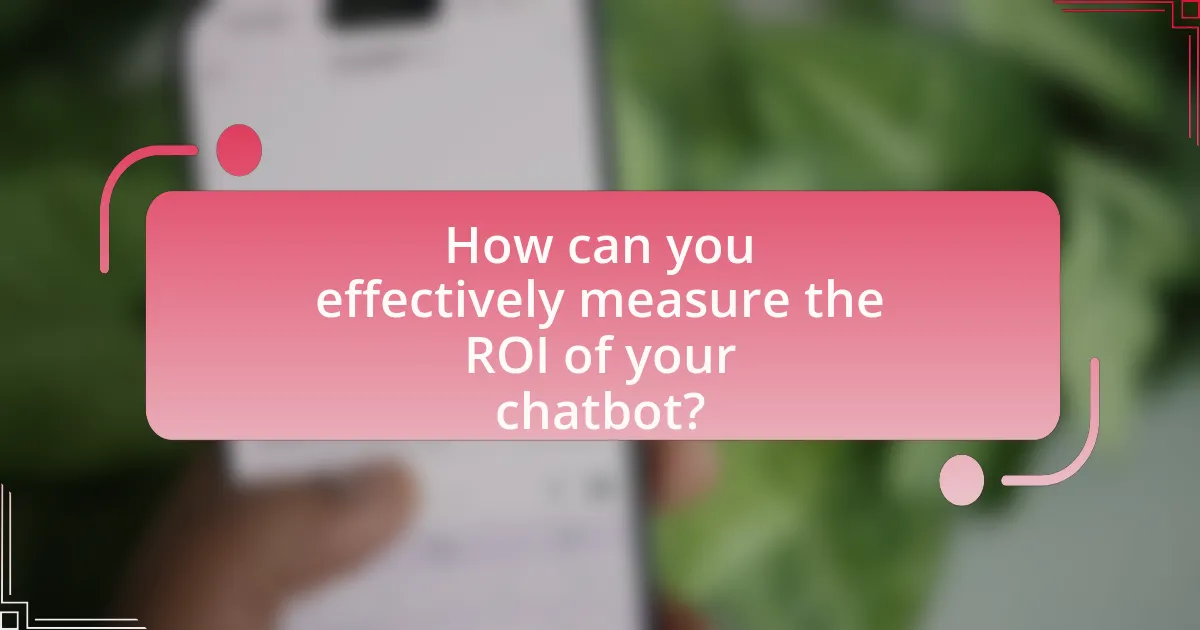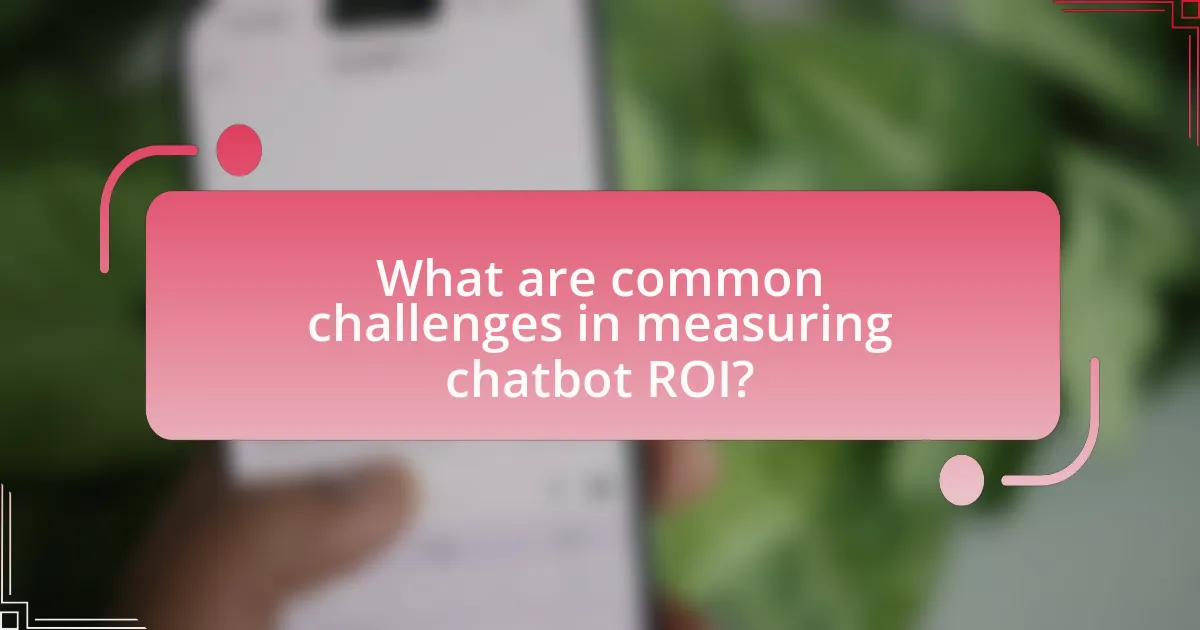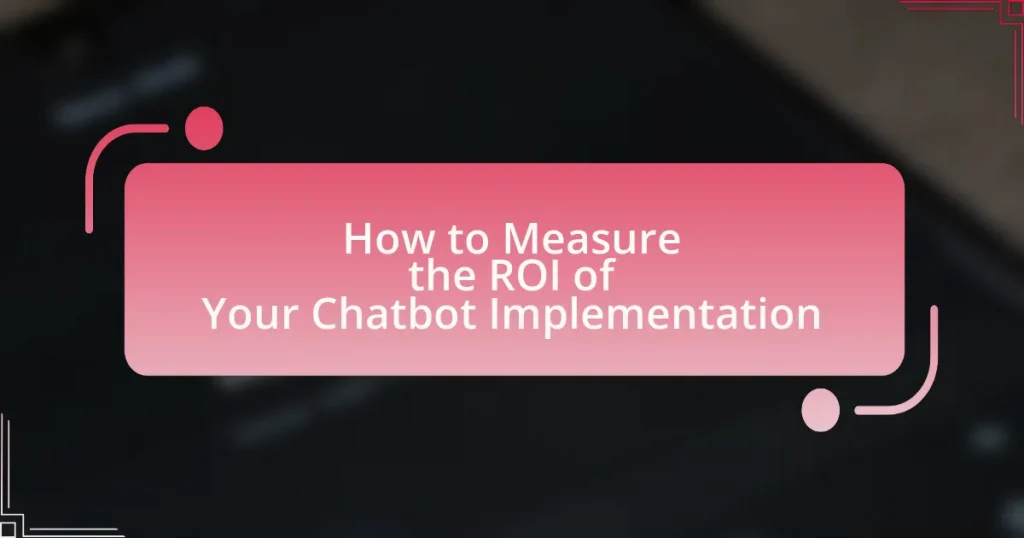The article focuses on measuring the Return on Investment (ROI) of chatbot implementation, emphasizing the financial benefits against the costs involved. It defines ROI in this context as the ratio of net profit generated by the chatbot to its total development and maintenance costs. Key metrics for calculating ROI include cost savings, increased sales, customer satisfaction scores, and engagement rates. The article also discusses factors influencing ROI, such as chatbot design and user adoption, and outlines best practices for maximizing ROI through clear goal setting, continuous optimization, and effective evaluation methods. Additionally, it addresses common challenges in measuring ROI and offers strategies to overcome these obstacles.

What is the ROI of Chatbot Implementation?
The ROI of chatbot implementation can be quantified by measuring the financial returns generated against the costs incurred in deploying the chatbot. Businesses typically experience a return on investment ranging from 200% to 400%, as chatbots can significantly reduce operational costs, enhance customer service efficiency, and increase sales through improved engagement. For instance, a study by Juniper Research estimates that chatbots will help businesses save over $8 billion annually by 2022 through reduced customer service costs. This demonstrates that the effective use of chatbots not only recoups initial investments but also contributes to substantial long-term savings and revenue growth.
How is ROI defined in the context of chatbot implementation?
ROI, or Return on Investment, in the context of chatbot implementation is defined as the ratio of net profit generated by the chatbot to the total costs associated with its development and maintenance. This calculation allows organizations to assess the financial benefits derived from deploying a chatbot against the expenses incurred. For instance, if a company invests $50,000 in a chatbot and subsequently generates $150,000 in savings or additional revenue, the ROI would be calculated as ($150,000 – $50,000) / $50,000, resulting in an ROI of 2, or 200%. This metric is crucial for evaluating the effectiveness and financial viability of chatbot solutions in enhancing customer service, reducing operational costs, and driving sales.
What metrics are used to calculate ROI for chatbots?
The metrics used to calculate ROI for chatbots include cost savings, increased sales, customer satisfaction scores, and engagement rates. Cost savings are derived from reduced operational expenses, such as decreased customer service staffing needs, while increased sales can be measured through the chatbot’s ability to facilitate transactions or lead generation. Customer satisfaction scores, often gathered through surveys, indicate the effectiveness of the chatbot in meeting user needs. Engagement rates, which track user interactions with the chatbot, provide insights into its usage and effectiveness. These metrics collectively help organizations assess the financial impact and overall value of their chatbot implementations.
Why is measuring ROI important for chatbot projects?
Measuring ROI is important for chatbot projects because it quantifies the financial benefits gained from the investment in the chatbot against its costs. This measurement allows organizations to assess the effectiveness of the chatbot in achieving business objectives, such as reducing operational costs, improving customer satisfaction, and increasing sales. For instance, a study by Juniper Research found that chatbots can save businesses up to $8 billion annually by 2022 through improved customer service efficiency. By evaluating ROI, companies can make informed decisions about scaling, optimizing, or discontinuing chatbot initiatives based on their performance and impact on the bottom line.
What factors influence the ROI of chatbot implementation?
The ROI of chatbot implementation is influenced by several key factors, including the chatbot’s design, the quality of its natural language processing capabilities, integration with existing systems, user adoption rates, and the specific use cases it addresses. A well-designed chatbot that effectively understands and responds to user queries can significantly enhance customer satisfaction and reduce operational costs. For instance, a study by Juniper Research found that chatbots could save businesses up to $8 billion annually by 2022 through improved customer service efficiency. Additionally, seamless integration with CRM systems can streamline workflows, further enhancing ROI. User adoption is critical; higher engagement rates lead to better returns, as evidenced by a report from Gartner, which indicates that by 2025, 75% of customer service interactions will be powered by AI, underscoring the importance of user acceptance in realizing ROI.
How do operational costs affect chatbot ROI?
Operational costs significantly impact chatbot ROI by determining the overall profitability of the chatbot implementation. High operational costs, such as maintenance, updates, and staffing, can reduce the net returns generated by the chatbot, making it less effective in delivering a positive ROI. For instance, if a company spends $50,000 annually on chatbot operations but only generates $30,000 in savings or revenue, the ROI becomes negative. Conversely, lower operational costs can enhance ROI by maximizing savings and revenue generated from the chatbot’s efficiency in handling customer inquiries and automating processes. Therefore, managing operational costs is crucial for achieving a favorable ROI in chatbot implementations.
What role does customer engagement play in determining ROI?
Customer engagement significantly influences ROI by directly impacting customer retention and sales conversion rates. Engaged customers are more likely to make repeat purchases and recommend products, leading to increased revenue. For instance, a study by Gallup found that highly engaged customers contribute 23% more to the bottom line compared to average customers. This correlation highlights that effective customer engagement strategies, such as personalized interactions through chatbots, can enhance customer satisfaction and loyalty, ultimately driving higher ROI.

How can you effectively measure the ROI of your chatbot?
To effectively measure the ROI of your chatbot, calculate the financial benefits generated by the chatbot and compare them to the costs incurred in its implementation and maintenance. Start by quantifying metrics such as increased sales, reduced customer service costs, and improved customer satisfaction scores attributable to the chatbot. For instance, if a chatbot reduces average handling time by 30%, this can lead to significant savings in labor costs. Additionally, track user engagement metrics and conversion rates to assess the chatbot’s impact on sales. By analyzing these data points, you can derive a clear ROI percentage, demonstrating the financial value of the chatbot relative to its costs.
What steps should be taken to measure chatbot ROI?
To measure chatbot ROI, organizations should follow these steps: first, define clear objectives for the chatbot, such as reducing customer service costs or increasing sales. Next, track relevant metrics, including cost savings, increased revenue, customer satisfaction scores, and engagement rates. Then, calculate the total costs associated with the chatbot, including development, maintenance, and operational expenses. Finally, compare the financial benefits derived from the chatbot against these costs to determine the ROI percentage. For instance, if a chatbot reduces customer service costs by $50,000 while costing $10,000 to implement, the ROI would be 400%. This structured approach ensures a comprehensive evaluation of the chatbot’s financial impact.
How do you set clear objectives for your chatbot?
To set clear objectives for your chatbot, first identify the specific goals you want to achieve, such as improving customer service response times or increasing sales conversions. These objectives should be measurable, allowing you to track progress and evaluate success. For instance, if the goal is to enhance customer service, you might aim for a 30% reduction in response time within three months. Establishing these quantifiable targets enables you to assess the chatbot’s performance effectively and determine its return on investment (ROI).
What data collection methods are most effective for measuring ROI?
The most effective data collection methods for measuring ROI include surveys, analytics tools, and A/B testing. Surveys gather direct feedback from users regarding their experiences and satisfaction, which can be correlated with financial outcomes. Analytics tools, such as Google Analytics, track user interactions and conversions, providing quantitative data on how the chatbot influences sales or engagement. A/B testing allows for comparison between different versions of the chatbot to determine which performs better in terms of user engagement and conversion rates. These methods collectively provide a comprehensive view of the chatbot’s impact on ROI, supported by data-driven insights.
What tools and techniques can assist in measuring chatbot ROI?
Tools and techniques that assist in measuring chatbot ROI include analytics platforms, customer satisfaction surveys, and cost-benefit analysis. Analytics platforms, such as Google Analytics and Chatbase, track user interactions, conversion rates, and engagement metrics, providing quantitative data on chatbot performance. Customer satisfaction surveys gauge user experience and satisfaction levels, offering qualitative insights that can be correlated with ROI. Cost-benefit analysis evaluates the financial impact of chatbot implementation by comparing operational costs against savings generated through increased efficiency and reduced customer service expenses. These methods collectively provide a comprehensive view of chatbot effectiveness and financial return.
Which analytics platforms are best for tracking chatbot performance?
The best analytics platforms for tracking chatbot performance include Google Analytics, Chatbase, and Botanalytics. Google Analytics allows for comprehensive tracking of user interactions and engagement metrics, providing insights into user behavior and conversion rates. Chatbase specializes in analyzing chatbot conversations, offering detailed reports on user retention and satisfaction. Botanalytics focuses on visualizing chatbot data, enabling users to understand conversation flows and identify areas for improvement. These platforms are widely recognized for their effectiveness in measuring chatbot performance and optimizing user experience.
How can A/B testing contribute to understanding chatbot ROI?
A/B testing contributes to understanding chatbot ROI by allowing businesses to compare different versions of chatbot interactions to determine which one yields better performance metrics. This method enables organizations to analyze user engagement, conversion rates, and customer satisfaction across various chatbot designs or responses. For instance, a study by the Nielsen Norman Group found that A/B testing can lead to a 20% increase in user satisfaction when the more effective version is identified and implemented. By quantifying these improvements, businesses can directly correlate enhanced chatbot performance with increased revenue or cost savings, thus providing a clearer picture of the chatbot’s return on investment.

What are common challenges in measuring chatbot ROI?
Common challenges in measuring chatbot ROI include difficulty in quantifying intangible benefits, lack of standardized metrics, and data integration issues. Intangible benefits, such as improved customer satisfaction or brand loyalty, are hard to measure with concrete numbers. Additionally, organizations often lack standardized metrics for evaluating chatbot performance, leading to inconsistent assessments. Data integration issues arise when combining chatbot data with other business metrics, complicating the analysis of overall impact. These challenges hinder accurate ROI calculations and can lead to misinformed business decisions.
What obstacles might you face when calculating ROI?
When calculating ROI for chatbot implementation, common obstacles include difficulty in quantifying benefits, lack of historical data, and challenges in attributing revenue directly to the chatbot. Quantifying benefits can be complex due to the intangible nature of customer satisfaction and engagement metrics, which may not translate directly into financial figures. Additionally, organizations often lack historical data to establish a baseline for comparison, making it hard to measure improvements accurately. Finally, attributing revenue specifically to chatbot interactions can be problematic, as multiple factors influence sales and customer behavior, complicating the analysis of the chatbot’s direct impact on ROI.
How can data accuracy impact ROI measurements?
Data accuracy significantly impacts ROI measurements by ensuring that the financial benefits attributed to a chatbot implementation are based on reliable and valid data. When data is accurate, organizations can confidently assess the true value generated by the chatbot, such as cost savings from reduced customer service inquiries or increased sales from improved customer engagement. Conversely, inaccurate data can lead to misleading ROI calculations, resulting in overestimations or underestimations of the chatbot’s effectiveness. For instance, a study by the Harvard Business Review found that companies with high data accuracy reported 20% higher ROI on technology investments compared to those with poor data quality. This demonstrates that accurate data is crucial for making informed decisions and optimizing the financial outcomes of chatbot implementations.
What are the limitations of traditional ROI calculations for chatbots?
Traditional ROI calculations for chatbots often fail to capture the full value of their implementation due to several limitations. These calculations typically focus on direct financial metrics, such as cost savings and revenue generation, while neglecting qualitative benefits like improved customer satisfaction and enhanced user experience. Additionally, traditional methods may overlook long-term impacts, such as brand loyalty and customer retention, which are critical for assessing a chatbot’s overall effectiveness. Furthermore, ROI calculations often rely on historical data that may not accurately reflect future performance, especially in rapidly evolving digital environments. This narrow focus can lead to an incomplete understanding of a chatbot’s true value, ultimately hindering informed decision-making regarding its deployment and optimization.
How can you overcome these challenges?
To overcome the challenges of measuring the ROI of chatbot implementation, organizations should establish clear metrics and KPIs aligned with business objectives. By defining specific goals such as increased customer satisfaction, reduced operational costs, or improved response times, companies can effectively track performance. For instance, a study by Juniper Research indicates that chatbots can save businesses up to $8 billion annually by 2022 through enhanced customer service efficiency. Implementing analytics tools to monitor user interactions and feedback will provide concrete data to assess the chatbot’s impact on ROI.
What best practices can improve the accuracy of ROI measurements?
To improve the accuracy of ROI measurements, organizations should implement standardized metrics and consistent data collection methods. Standardized metrics ensure that all stakeholders are evaluating ROI using the same criteria, which enhances comparability and reliability. Consistent data collection methods, such as tracking user interactions and conversion rates over time, provide a comprehensive view of performance. According to a study by the Harvard Business Review, companies that utilize standardized metrics report a 30% increase in the accuracy of their ROI assessments. Additionally, integrating qualitative feedback from users can provide context to quantitative data, further refining the accuracy of ROI calculations.
How can continuous improvement strategies enhance chatbot ROI?
Continuous improvement strategies enhance chatbot ROI by systematically optimizing performance and user engagement. By regularly analyzing user interactions and feedback, organizations can identify areas for enhancement, such as improving response accuracy and reducing resolution times. For instance, a study by IBM found that chatbots that undergo continuous updates can increase user satisfaction by up to 30%, leading to higher retention rates and increased sales. Additionally, implementing A/B testing for different conversational flows allows businesses to determine the most effective approaches, further driving ROI. This iterative process ensures that chatbots remain relevant and effective, maximizing their value over time.
What are the best practices for maximizing chatbot ROI?
To maximize chatbot ROI, businesses should focus on clear goal setting, continuous optimization, and user experience enhancement. Establishing specific objectives, such as reducing customer service costs or increasing sales conversions, allows for targeted performance measurement. Continuous optimization involves analyzing user interactions and feedback to refine the chatbot’s responses and capabilities, which can lead to improved customer satisfaction and engagement. Enhancing user experience by ensuring the chatbot is intuitive and provides valuable information can significantly increase user retention and conversion rates. According to a study by Juniper Research, chatbots are expected to save businesses over $8 billion annually by 2022 through improved customer service efficiency and reduced operational costs, highlighting the financial benefits of implementing these best practices.
How can you align chatbot goals with business objectives?
To align chatbot goals with business objectives, organizations must first identify key performance indicators (KPIs) that reflect both the chatbot’s intended functions and the broader business aims. For instance, if a business objective is to enhance customer satisfaction, the chatbot’s goal should include metrics such as response time and user satisfaction ratings. Research indicates that companies that effectively align their chatbot functionalities with business goals see a 30% increase in customer engagement and a 20% reduction in operational costs, demonstrating the tangible benefits of this alignment. By continuously monitoring these KPIs and adjusting the chatbot’s capabilities accordingly, businesses can ensure that their chatbot remains a valuable asset in achieving overall strategic objectives.
What ongoing evaluation methods should be implemented for sustained ROI?
Ongoing evaluation methods for sustained ROI in chatbot implementation include regular performance analytics, user feedback collection, and A/B testing. Performance analytics should focus on key metrics such as user engagement rates, resolution times, and customer satisfaction scores, which provide quantifiable data on the chatbot’s effectiveness. User feedback collection through surveys and direct interactions helps identify areas for improvement and user experience enhancements. A/B testing allows for experimentation with different chatbot features or responses, enabling data-driven decisions that optimize performance. These methods collectively ensure that the chatbot continues to meet business objectives and delivers value over time.










